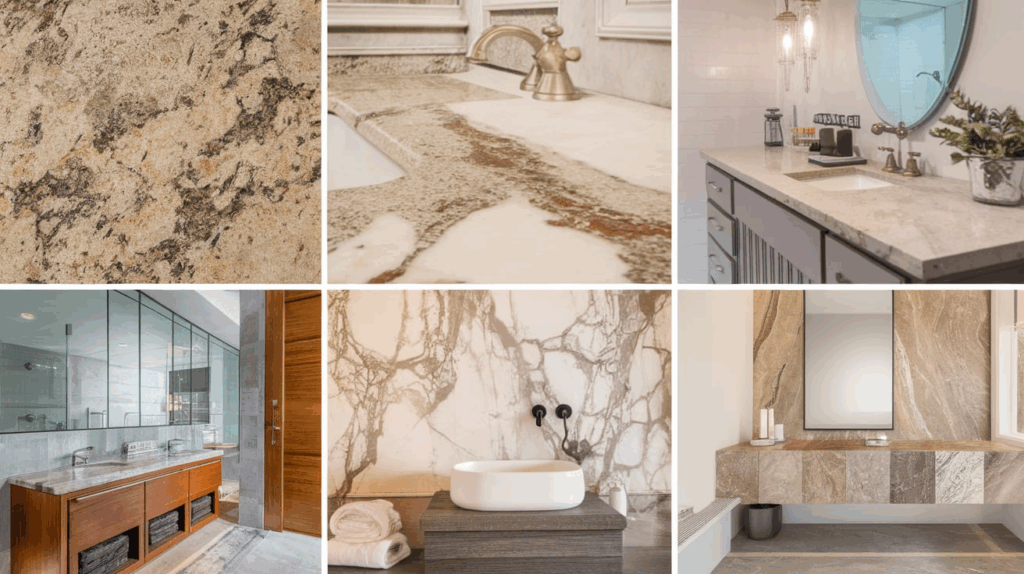Picking the right material for your bathroom countertop can be a big decision. There are numerous options available, including granite, quartz, marble, laminate, and more.
Each one looks different and has its own advantages and disadvantages. Some are easy to clean, others are less expensive, and a few last longer than the rest.
I know it can feel a little overwhelming at first. That’s why I put together this guide to help you learn about the most popular bathroom countertop materials.
I’ll go over the pros, cons, costs, and key considerations before you make a decision. If you’re remodeling or just updating your bathroom, this list will help you make a smart pick.
Let’s take a closer look at the top materials people love to use for bathroom countertops.
Why Does Choosing the Right Countertop Matter?
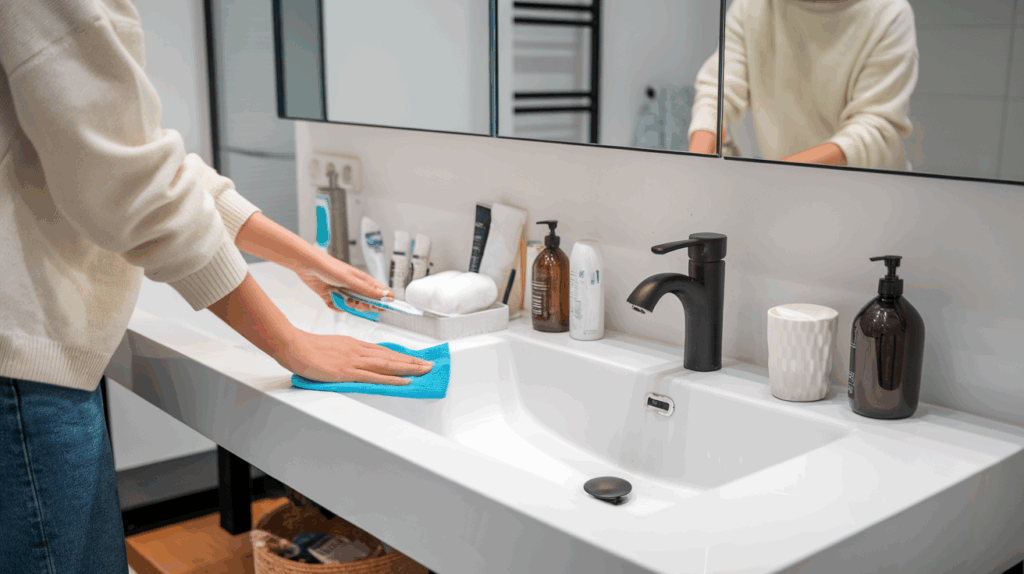
Bathroom countertops do more than hold your sink. They’re used every day for brushing teeth, washing hands, or storing your belongings.
A good countertop handles water, soap, and spills without getting damaged.
It also makes cleaning faster and easier. The right material can last for years without stains, cracks, or chips.
That means less stress, fewer repairs, and money saved over time. A strong countertop also keeps your bathroom looking neat and stylish.
Because it’s one of the first things people notice, a nice countertop can improve the whole look of your space. And if you plan to sell your home later, it can even add value.
Choosing the right countertop helps your bathroom work better, stay clean, and look good, all while saving you time and effort.
What to Think About Before You Choose?
Before selecting a bathroom countertop, it’s helpful to consider how you’ll use it and what matters most to you. Some key things to keep in mind are:
1. Budget: Countertop costs vary a lot. Laminate and tile are budget-friendly. Quartz and marble cost more but look high-end. Don’t forget to factor in installation, sealing, and upkeep.
2. Durability: If your bathroom gets a lot of use, especially by kids, you’ll want a countertop that resists stains and scratches. Quartz and granite are strong and last long. Softer options like wood or marble may need more care and can wear faster.
3. Maintenance: Some materials need sealing and special care. Others, like quartz or laminate, are easier to clean with soap and water. Think about how much time you want to spend on upkeep. If you prefer easy cleaning, go with a low-maintenance material.
4. Style: The countertop should match your bathroom’s look. Marble and wood feel classic and warm. Quartz and solid surface offer a modern vibe. Laminate and tile come in many colors and patterns. Bring samples home to see how they look in your lighting.
5. Water Resistance: Choose a material that can handle splashes and steam without damage. Quartz, glass, and sealed stone are water-resistant. Wood, laminate, and tile grout may get damaged if not sealed or cared for properly.
6. Sink Type: Drop-in sinks work with most materials. Undermount sinks need solid options like stone. Vessel sinks need a flat, sturdy top. Integrated sinks are part of the countertop and work best with solid surfaces.
Top Bathroom Countertop Materials to Consider
There are many types of materials used for bathroom countertops. Each one looks and feels different. Some are great for busy bathrooms. Others work best in quiet guest spaces.
1. Granite Countertops
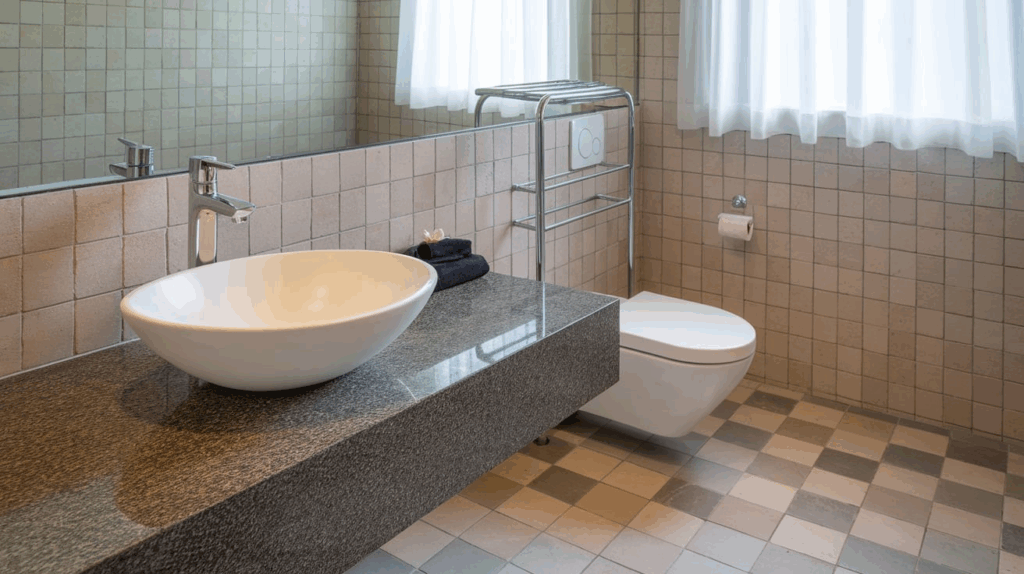
Granite countertops offer beautiful natural patterns and exceptional durability. Resistant to moisture and scratches, they enhance bathroom spaces with unique colors.
Though pricier, these rock-solid surfaces provide long-lasting performance, making them an excellent choice for both family and guest bathrooms.
Pros:
- Long-lasting and hard to scratch
- Can handle heat from curling irons or hot water
- Adds a high-end look to the bathroom
Cons:
- Expensive compared to other materials
- Needs sealing every year to prevent stains
- Heavy needs strong cabinets
Good for: Master bathrooms or busy bathrooms where looks and strength both matter.
2. Quartz Countertops
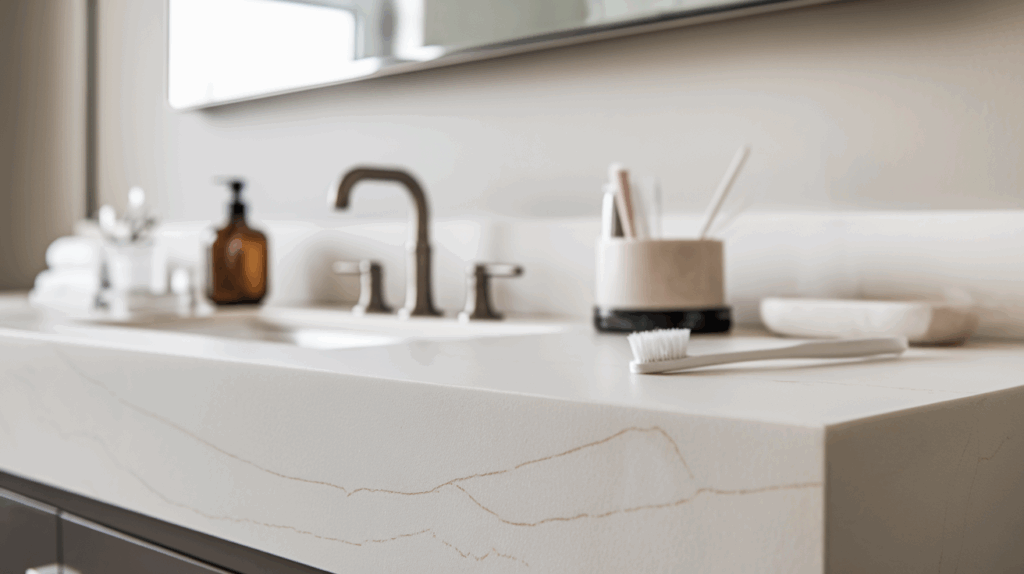
Quartz countertops combine crushed stone with resin, creating a strong, non-porous surface. Engineered for durability, these counters resist stains and bacteria.
Their consistent patterns and colors offer a modern, clean look that works well in contemporary bathroom designs.
Pros:
- Very strong and doesn’t chip or crack easily
- No sealing needed
- Resists water, stains, and bacteria
- Comes in many colors and patterns, even ones that look like marble or granite
Cons:
- More costly than some other options
- Can discolor in direct sunlight
- Can be damaged by very high heat
Good for: Family bathrooms or high-use spaces where easy cleaning is a must.
3. Marble Countertops
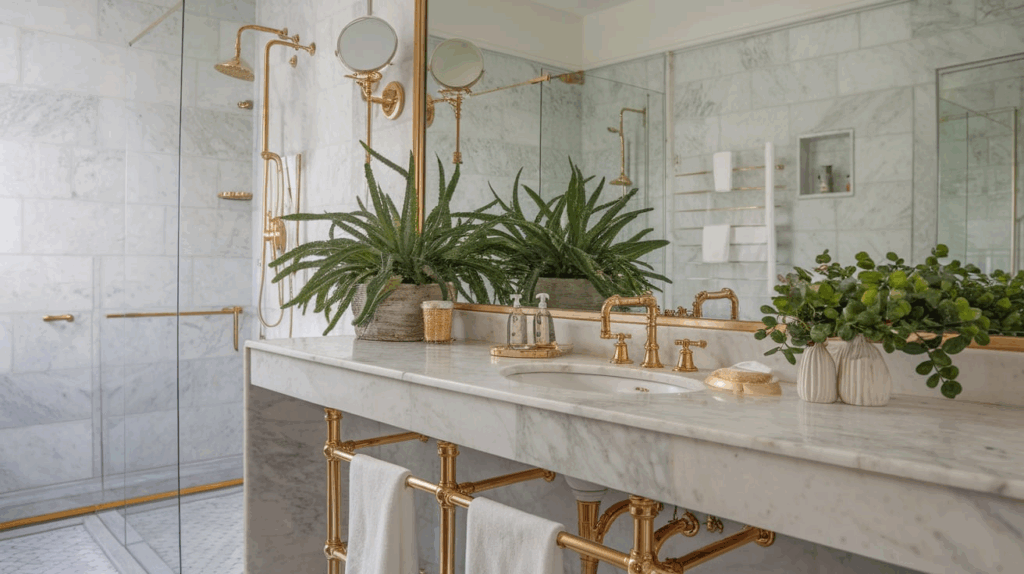
Marble brings natural beauty to bathrooms with its distinctive veining and soft stone appearance.
Each slab features unique patterns, creating a classic look that adds refined beauty. While delicate, it provides a premium touch to your bathroom’s overall design.
Pros:
- Luxurious and brightens the space
- Every slab is one-of-a-kind
- Stays cool, great for makeup or skincare lovers
Cons:
- Scratches and stains easily
- Needs sealing often
- Expensive
Good for: Guest bathrooms or low-use spaces where you want a fancy, high-end look.
4. Laminate Countertops
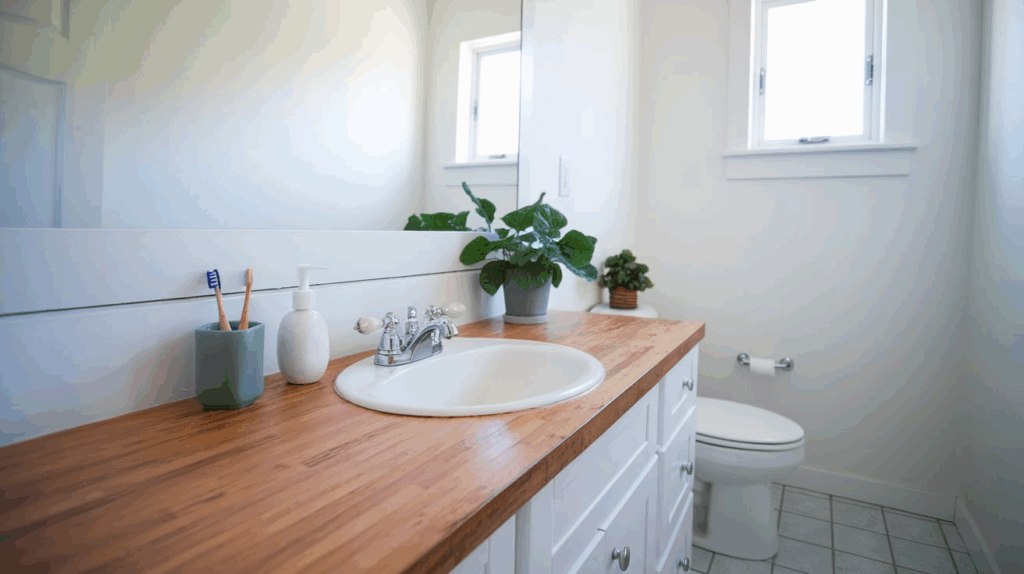
Laminate countertops combine paper and resin layers with printed surfaces that imitate stone or wood. Affordable and lightweight, they offer versatile design options.
Easy to install and maintain, laminate provides a practical solution for budget-conscious bathroom renovations with multiple style choices.
Pros:
- Low cost and easy to install
- Light in weight
- No sealing needed
Cons:
- Can chip, burn, or scratch
- Doesn’t handle moisture well around seams
- Hard to repair once damaged
Good for: Half baths, powder rooms, or quick, budget-friendly remodels.
5. Solid Surface Countertops
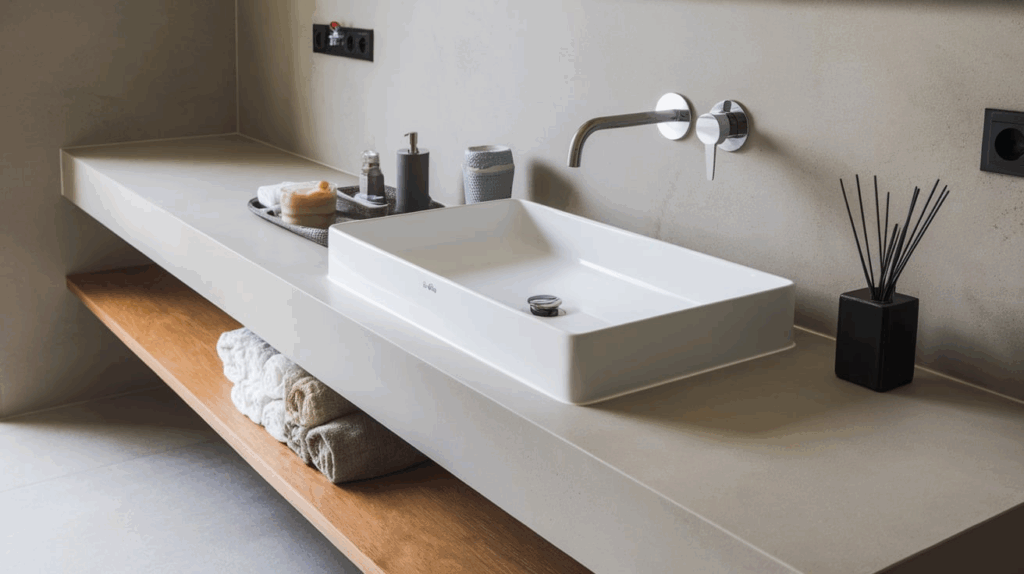
Corian countertops blend acrylic and resins to create a smooth, seamless surface. These materials offer a soft, modern appearance with minimal visible seams.
Highly adaptable, they provide a non-porous, easy-to-clean option for bathrooms, allowing for custom shapes and integrated sinks.
Pros:
- Seamless and modern
- Resists stains and bacteria
- Can be used with integrated sinks
Cons:
- Scratches more easily than stone
- Can be burned by heat tools
- More costly than laminate
Good for: Sleek, modern bathrooms that need a smooth and easy-to-clean surface.
6. Tile Countertops
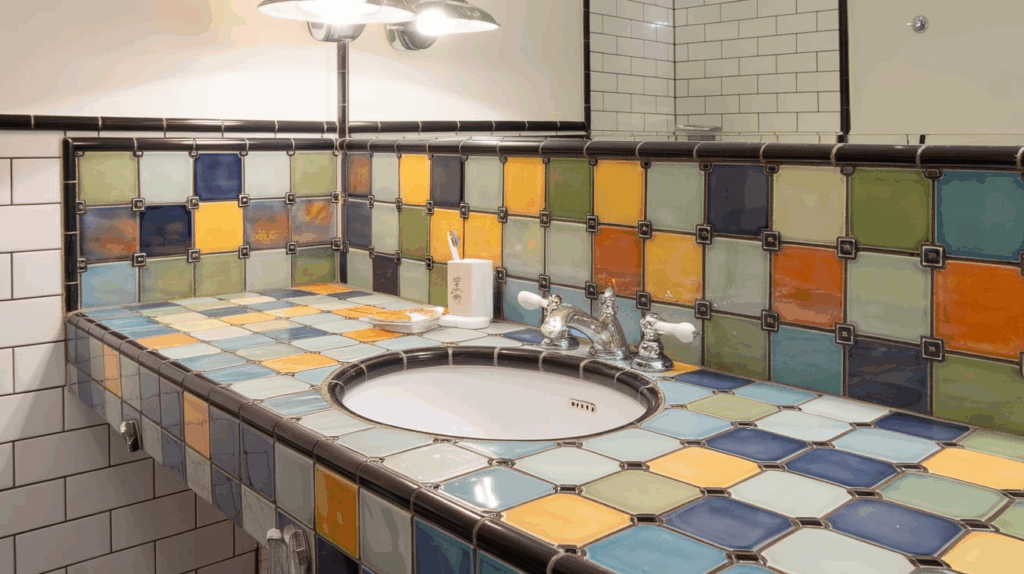
Tile countertops combine ceramic, porcelain, or natural stone pieces set in grout over a base surface.
They offer versatile design options with endless color and pattern possibilities. Durable and water-resistant, tiles provide a customizable, cost-effective solution for bathroom counters.
Pros:
- Can match floors or shower tiles
- Inexpensive if you install it yourself
- Easy to replace a single tile if it cracks
Cons:
- Grout can stain and trap dirt
- Not a smooth surface
- Can chip at the edges
Good for: Creative bathrooms with a personal touch or vintage style.
7. Concrete Countertops
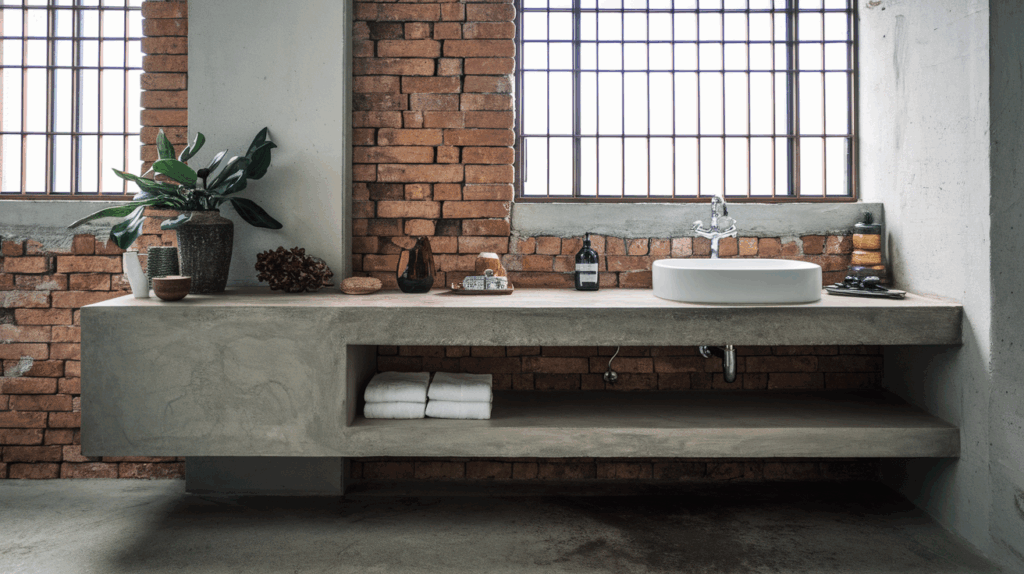
Concrete countertops are custom-poured and shaped to fit your bathroom precisely. Malleable and adaptable, they can be tinted or stamped with unique patterns.
These surfaces offer a raw, industrial feel while providing a strong, personalized touch to your bathroom design.
Pros:
- Fully custom shape and finish
- Very strong and heat-resistant
- Adds a bold, industrial touch
Cons:
- Needs sealing to prevent stains
- Can crack with time
- Cost can be high for custom work
Good for: Modern or industrial-style bathrooms with unique layouts.
8. Butcher Block (Wood) Countertops
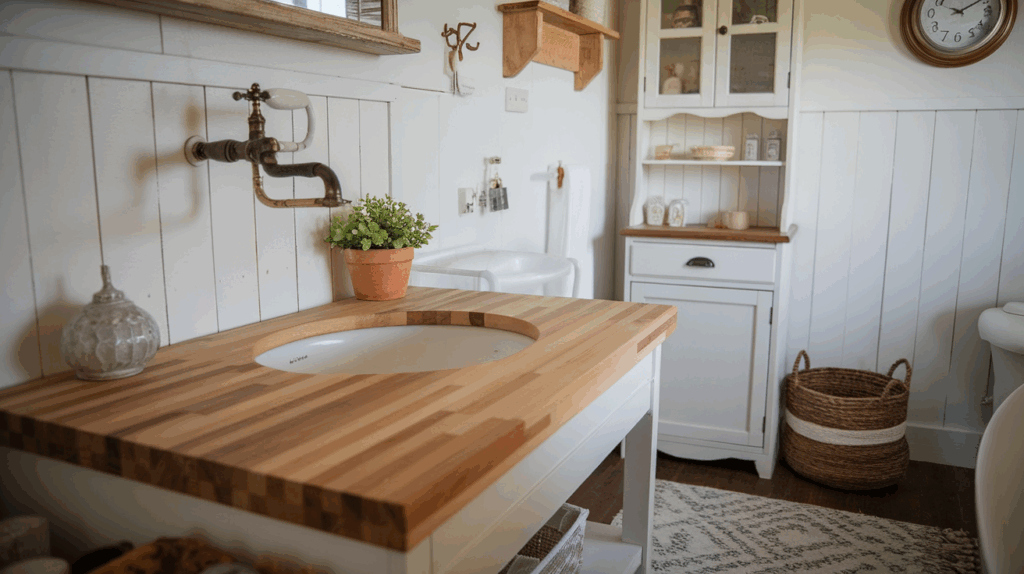
Wood countertops feature strips of lumber glued together, creating a warm, natural surface. They bring organic texture and comfort to bathroom spaces.
While requiring careful maintenance, these counters offer a rich, inviting look that adds character and depth to your design.
Pros:
- Natural, cozy feel
- Can be sanded and refinished
- Matches well with farmhouse or rustic designs
Cons:
- Needs regular sealing
- Can warp or stain from water
- Not ideal for high-moisture areas
Good for: Powder rooms or bathrooms where water use is low.
9. Glass Countertops
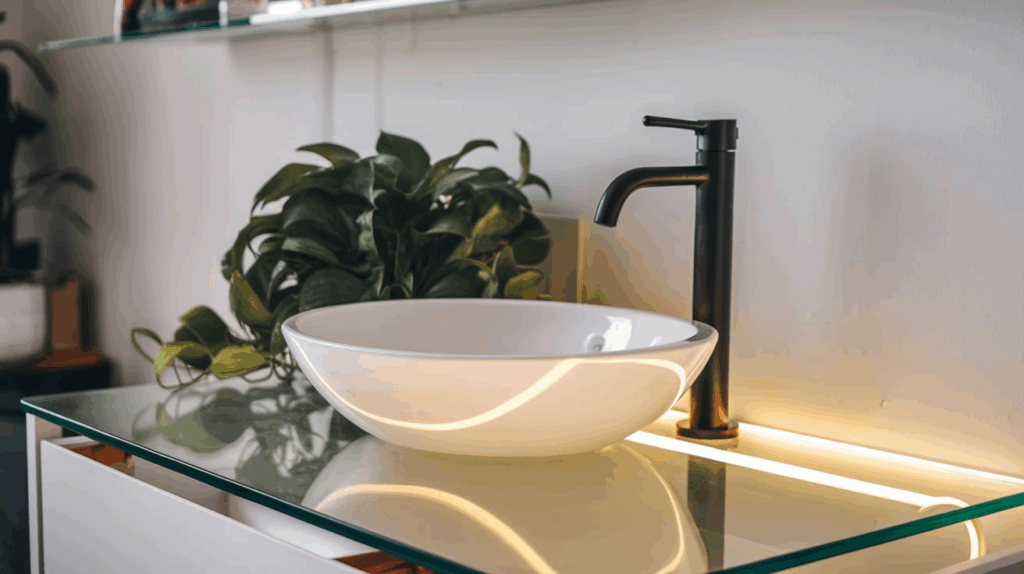
Glass countertops are crafted from thick, tempered material, offering a sleek and modern bathroom look.
Transparent or tinted, they create a sense of open space. Resistant to stains and easy to clean, glass surfaces provide a unique, contemporary design element.
Pros:
- Doesn’t stain
- Resists water and heat
- Can be backlit for a cool glow
Cons:
- Shows fingerprints and spots
- Can crack if hit hard
- Expensive and custom-built
Good for: Upscale, modern bathrooms or small spaces where you want to make a big visual impact.
10. Recycled Material Countertops
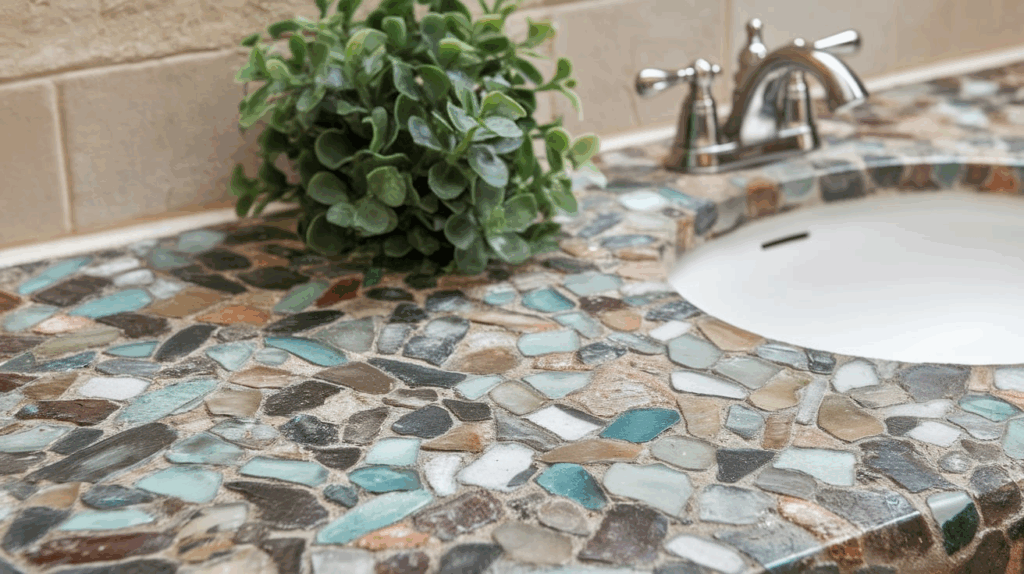
Recycled material countertops blend glass, paper, or metal fragments set in resin or concrete. These eco-friendly surfaces offer unique patterns and colors while reducing environmental impact.
They provide a sustainable, creative solution for bathrooms seeking both style and responsible design.
Pros:
- Eco-friendly
- Unique patterns and colors
- Strong and durable
Cons:
- It can be hard to find
- Prices vary
- May chip depending on the material
Good for: Green homes or anyone who wants a stylish, planet-friendly surface.
11. Soapstone Countertops
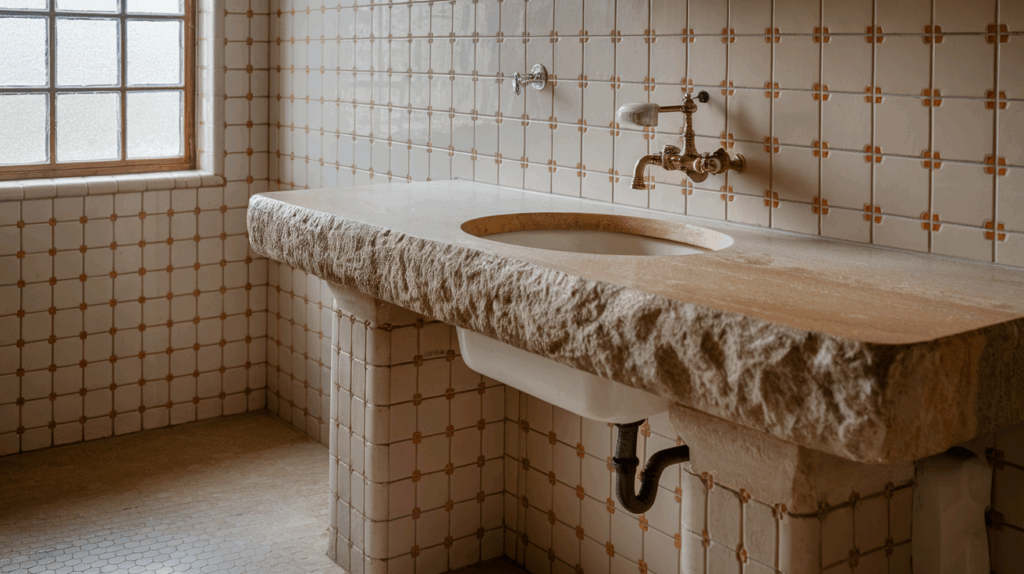
Soapstone countertops feature a smooth, soft natural stone surface that darkens with age.
Naturally heat-resistant and non-porous, they develop a rich patina over time. These counters offer a vintage, rustic touch that adds depth and character to bathroom spaces.
Pros:
- Doesn’t need sealing
- Resists heat, water, and stains
- Great for vintage or farmhouse styles
Cons:
- Scratches more easily
- Limited color range (mostly gray or green)
- Needs oiling to keep the dark color
Good for: Older homes, cozy designs, or anyone wanting a low-shine look.
12. Stainless Steel Countertops
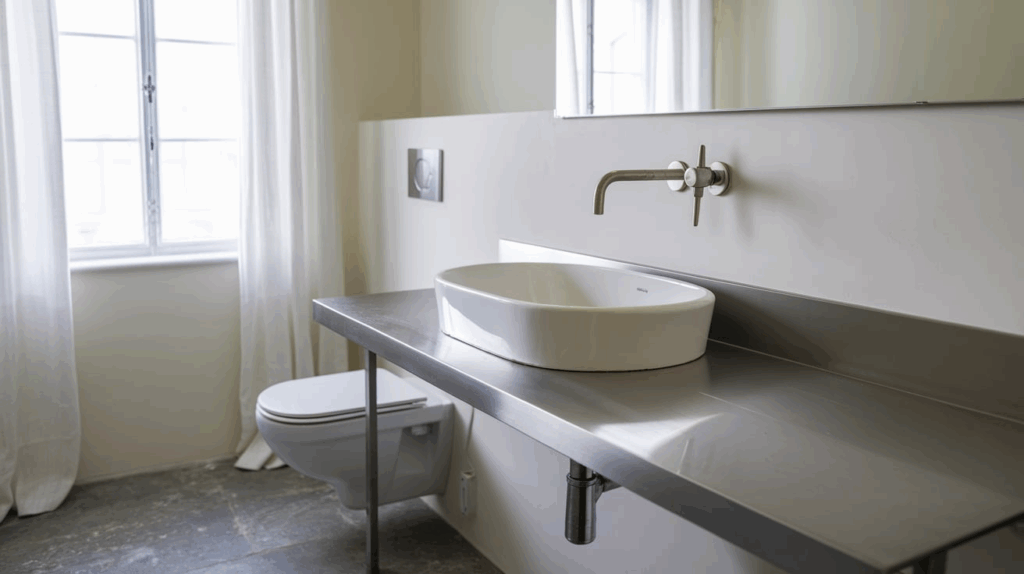
Stainless steel countertops, typically common in kitchens, bring a bold, modern look to bathrooms.
Highly durable and resistant to bacteria, these surfaces offer a sleek, industrial look. They provide a clean, professional appearance that stands up to daily use and moisture.
Pros:
- Heat-proof and stain-proof
- Super easy to clean
- Great for modern or industrial spaces
Cons:
- Shows smudges and scratches
- Can feel cold or too shiny for some
- Costly and loud if not padded
Good for: Very modern bathrooms or commercial-style spaces.
Bathroom Countertop Edges
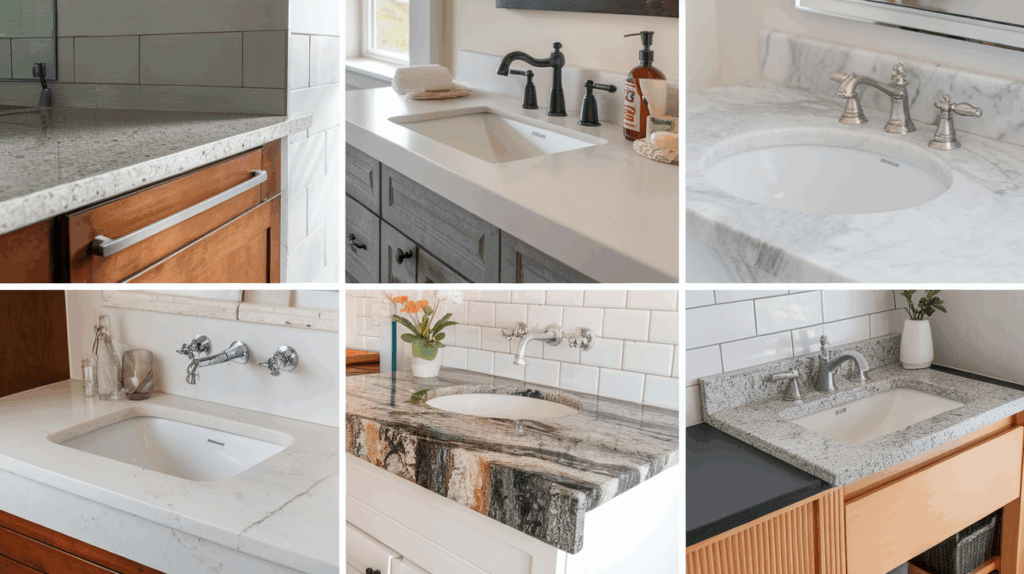
When picking your bathroom countertop, don’t forget about the edges. The edge style may seem like a minor detail, but it significantly affects how the countertop looks, feels, and even its safety, especially for children.
1. Straight Edge
Also called a square edge, this style is clean and simple. It has a sharp, flat shape with just a tiny bit of rounding for safety. Its best for modern or minimalist bathrooms.
Pros: Easy to clean, sharp-looking
Cons: Can chip more easily if the edge is too thin
2. Beveled Edge
This edge is cut at an angle (usually 45 degrees), giving it a slanted look on the top edge. Its best for traditional or updated bathrooms.
Pros: Adds a bit of style without going over the top
Cons: Slightly harder to wipe clean at the angled cut
3. Rounded Edge (Eased or Bullnose)
The rounded edge is fully or partly rounded. It’s soft to the touch and safer for families. It works best for family or kids’ bathrooms.
Pros: No sharp corners, easy to clean
Cons: Can look plain if you want something more decorative
4. Ogee Edge
Ogee edge has a fancy S-shaped curve, often seen in classic or luxury designs. Its best for classy or high-end bathrooms.
Pros: Very stylish and rich-looking
Cons: More expensive, harder to clean in the curves
5. Waterfall Edge
This edge goes straight down the sides of the cabinets for a smooth, continuous look. And its best suitable for modern bathrooms with floating vanities or open sides.
Pros: Bold and seamless design
Cons: Expensive and only fits certain layouts
6. Mitered Edge
Mitered edge makes the countertop look thicker by joining two pieces at an angle. It’s great for adding drama. This one is best suitable for contemporary bathrooms.
Pros: Gives a thick, classy feel
Cons: May cost more for custom cuts
Matching with Sink Types
The countertop you pick should also work well with your sink. Follow this quick guide to choose effectively:
- Drop-in sinks: Sit in a hole cut into the top.
- Undermount sinks: Installed under the countertop, great with stone or quartz.
- Vessel sinks: Sit on top, so the counter needs to be sturdy and flat.
- Integrated sinks: Built right into solid surfaces, no seams at all.
Cost Comparison by Material
| Material | Price per Sq. Ft. (Approx.) | Installation Included? |
|---|---|---|
| Laminate | $15–$40 | Often yes |
| Tile | $20–$60 | Sometimes |
| Solid Surface | $50–$100 | Yes |
| Granite | $60–$120 | Yes |
| Quartz | $70–$130 | Yes |
| Marble | $80–$150 | Yes |
| Concrete | $75–$125 | Sometimes |
| Wood | $40–$100 | Sometimes |
| Glass | $75–$150 | Usually yes |
| Recycled materials | $60–$120 | Varies |
| Soapstone | $70–$120 | Yes |
| Stainless Steel | $100–$200 | Yes |
Countertop prices vary widely depending on material, location, and installation complexity.
Local suppliers offer the most accurate quotes. Factors like square footage, material quality, and labor costs significantly impact the final price.
Always request multiple estimates before deciding.
Tips for Picking the Best Material
- Think about how much water your bathroom sees
- If kids will use it, go for tough and easy-care materials
- Don’t go over budget. Style doesn’t have to cost a lot
- Test samples at home before you choose
- Ask about care and cleaning before you buy
Conclusion
Choosing the right bathroom countertop takes a little time, but it’s worth it. I hope this guide made things easier.
There are numerous great materials available, each with its own unique look, feel, and price. Some are strong and easy to clean. Others stand out with style and color.
Consider how often you use your bathroom, your budget, and the style you prefer.
A good countertop can last for years and make your space feel fresh. Don’t rush the decision.
Try out samples, ask questions, and ensure it meets your needs. I always like to see how things look in my space before making a decision.
With the right pick, your bathroom will look better, work better, and feel more like you.

